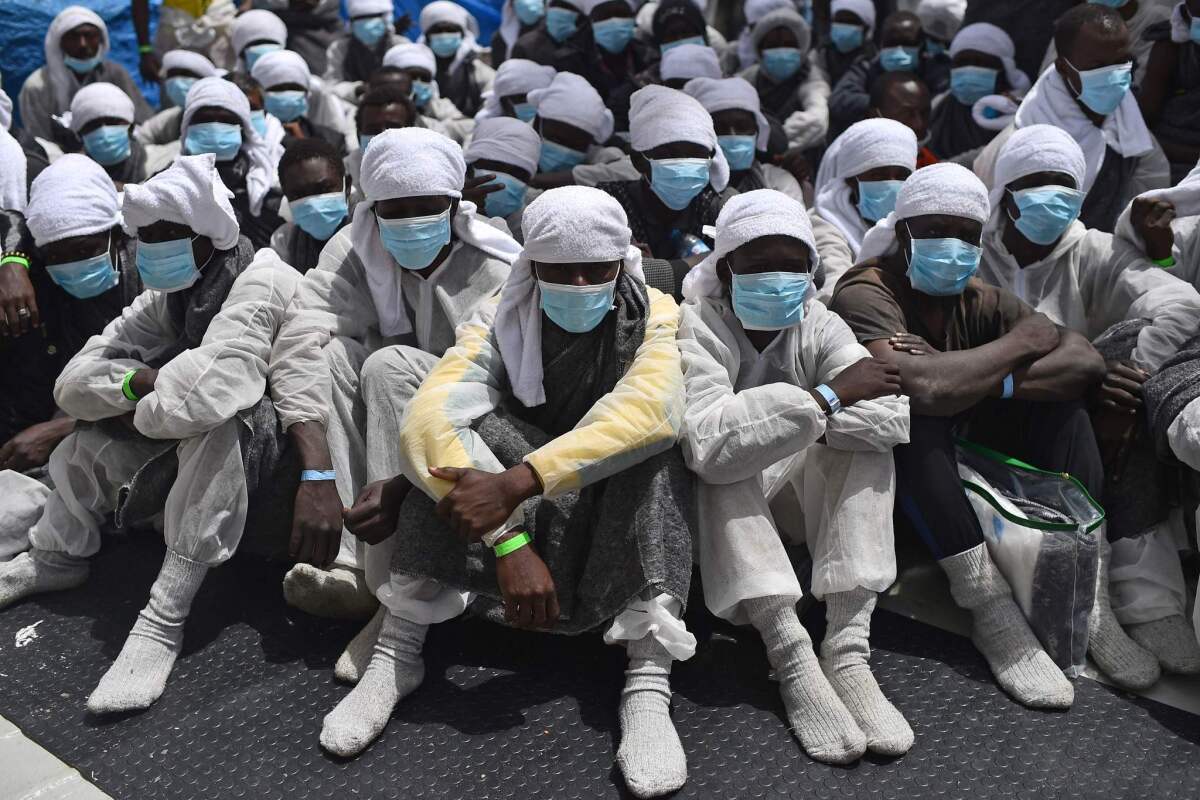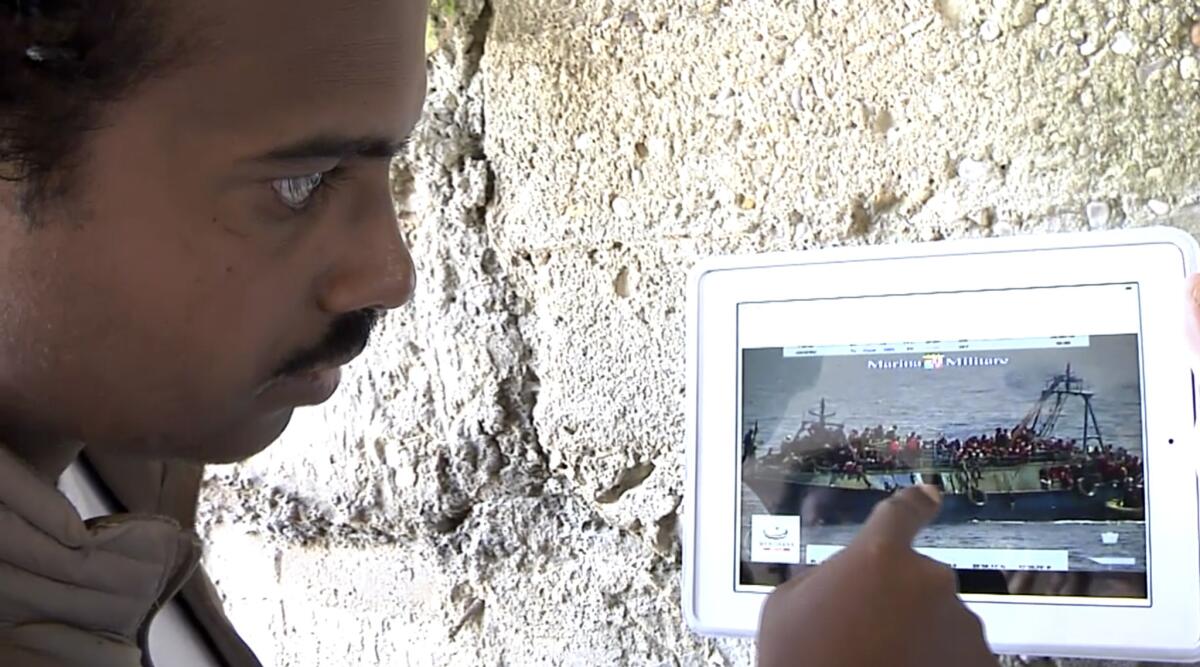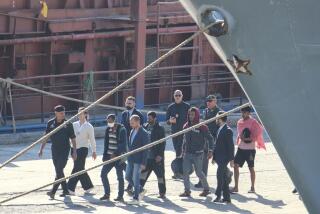Surge of migrant sailings has Italy scrambling to house thousands of new arrivals

Reporting from Palermo, Italy â A surge of migrant sailings from Libya and Egypt has sent government and aid officials in Italy scrambling to find beds for thousands of new arrivals.
More than 13,000 people have made the perilous crossing since Monday -- and hundreds have drowned in the attempt, the officials said.
Reception centers in Sicily, which received the bulk of the arrivals, are full. Even temporary shelters set up in disused sports halls and schools are overflowing, with some migrants relegated to a tent at their port of arrival, the international aid group Save the Children said.
Italian navy and coast guard vessels, as well as ships taking part in two different European Union rescue operations, have been scouring the Mediterranean Sea just beyond Libyan waters for the migrants.
About 900 of them were brought to the Sicilian port of Catania on Saturday after being plucked from overloaded dinghies and fishing boats in recent days. Some 700 others were sent to Pozzalo, also in Sicily, and 700 to Taranto, on the Italian mainland.
In Palermo, where 1,052 migrants arrived mid-week, police officials held hurried meetings and searched for interpreters after learning that 600 more would be showing up Sunday.
âTo have two landings like this in a week is unheard of,â said a senior police official, who was not authorized to speak publicly to the media.
On Saturday morning, the navy was waiting to hear where to send a ship carrying 135 people and 45 bodies recovered from a half-sunken rubber boat. The government has been trying to spread the load among different ports.
âWhere it goes may depend on who has the most coffins for the corpses,â a navy official remarked grimly.
It was later decided that the ship would go to the southern Italian city of Reggio Calabria.
And still the migrants kept coming. Another 668 people were plucked from the sea Saturday, the coast guard said.
âThis week has been the most intense this year and one of the busiest ever,â said Giovanna di Benedetto, a spokeswoman for Save the Children, which provides assistance to children who make the journey.
âWe are doing our best, but the landings are happening simultaneously in many different ports, and we are seeing lots of children traveling alone.â
There were at least four fatal sinkings in the Mediterranean last week.
As many as 200 migrants may have died when a wooden boat capsized Wednesday, hurling hundreds of people from the top deck into the sea, according to survivorsâ accounts.
Dramatic images taken by the Italian navy showed the survivors clambering onto the upturned hull before grabbing life jackets flung by sailors. Five bodies were recovered at the scene.
One of those rescued, 25-year-old Mohammed Ali, from Sudanâs western Darfur region, said he heard the screams of those trapped inside the two lower decks as the boat vanished beneath the surface.
Another survivor, Jamal Morsal Mohammed, also from Darfur, said he managed to escape by forcing open a locked hatch as the boat started to list.
âEveryone was screaming to get out of the lower decks, but some were not fast enough,â said Mohammed, a 25-year-old English student.
He didnât find his two brothers on the rescue ship. He presumes they drowned.

The survivors gathered in the hot sun Friday outside a disused hotel that has been converted into a reception center for migrants in Siculiana, a small, sleepy Sicilian town that boasts a castle built on the ruins of a fort dating back to the Arab occupation between the 9th and 11th centuries.
Bandaged and red-eyed from lack of sleep, the men borrowed a journalistâs cellphone to tell relatives they were alive and list which of their cousins and siblings had drowned. Within days, the group would be broken up and taken to smaller centers spread throughout Italy, where they may spend months waiting to hear whether they will be granted international protection and allowed to stay.
Up to 30 more migrants drowned Thursday when their vessel overturned, EU officials said last week.
And on Saturday, there came word that as many as 400 others may have died in a previously unreported sinking. Survivors who were picked up at sea and taken to Pozzallo reported the tragedy, Di Benedetto said.
The migrants told their rescuers they had set out from Libya on Wednesday evening in two fishing boats and a large inflatable dinghy. One of the boats was being towed by the other with a rope, but soon began to sink.
Some passengers managed to swim to the lead vessel and others reached it by dragging themselves along the rope. But early Thursday, the rope snapped. The sinking boat disappeared with hundreds still aboard, including women and children, survivors said.
With 115,000 migrants already hosted by Italy, last weekâs surge of arrivals prompted an appeal from the Interior Ministry to Italian towns to open more reception centers.
The roughly 46,000 migrants who have sailed this year is on par with the number seen by this time last year, according to the U.N. refugee agency. But this week was particularly busy, because of a period of good weather after sailings were held up by rough seas earlier in the month.
Many of those interviewed said they had lived and worked in Libya for extended periods, but had decided to leave because of escalating insecurity, or because their Libyan employers were refusing to pay them.
Rashid Jikkle, a 45-year-old Syrian from the embattled city of Aleppo, said he had worked as a builder in Libya for three years before fleeing fighting between militias, including militants loyal to the extremist group Islamic State that occupies parts of his country.
His 17-year-old son died in Wednesdayâs capsizing.
The number of Syrians attempting to reach European shores via the shorter and safer route between Turkey and the Greek islands dropped significantly after Turkey agreed in March to take back those who were not granted asylum in Greece.
But it does not appear that many Syrians are rerouting through North Africa. The majority of those setting sail from Libya and Egypt this year are from sub-Saharan Africa, officials said.
They include some 5,700 unaccompanied minors, nearly triple the number seen by this time last year, according to Save the Children.
Despite the dangers, parents continue to send children on their own, aid workers said. Other children lose their parents to the Sahara Desert or the Mediterranean Sea.
Giorgio Trizzino, director of Palermoâs childrenâs hospital, said he had treated scores of orphans who had lost parents during the migration, including a 5-year old Sudanese boy who arrived this week after his mother, brother and sister drowned.
The boy will be sent to a foster home in Italy.
âHe is in shock. He wonât eat and just nods ânoâ if you ask anything,â Trizzino said. âBut he is only 5, so if looked after well, I hope he will be able to get over this.â
ALSO
âDid you call 911?â Hereâs how one man reached out to his rescuers
On his trip to Vietnam and Japan, Obama reached for history despite the critics
The Philippines has 1.8 million abandoned children. Hereâs what keeps many from adoption
Kington is a special correspondent.
More to Read
Sign up for Essential California
The most important California stories and recommendations in your inbox every morning.
You may occasionally receive promotional content from the Los Angeles Times.










